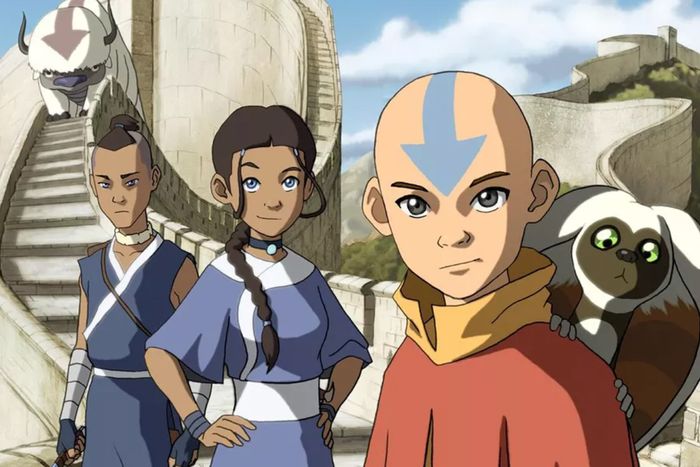
What Marketers Can Learn From “Avatar: The Last Airbender”
If you’ve been spending some extra time binging shows on Netflix these last few months, you are not alone.
In fact the #2 most popular show in July 2020 is an animated series called “Avatar: The Last Airbender.” In fact, I’ve watched and re-watched this show with each of my 4 kids. And now that it is getting some recognition for great storytelling, I thought it could offer some lessons for marketers as well.
So whether you’ve seen it or not (it’s pretty good!) I’ll use the storytelling framework from the show to offer lessons for marketers on content marketing and brand storytelling.
Quick Takeaways:
- Content marketers can learn a lot from the best storytelling examples.
- Great content marketing is really nothing more than a story that makes your customer the hero.
- Understanding storytelling structures can help us connect more deeply with our audiences.
Content Marketing Is Just a Conversation
The best definition of marketing is “a conversation between your company and your potential customers.” At least that’s what it’s supposed to be. And this is even more true in this age of tremendous disruption.
The goal of Content Marketing is to start that conversation with someone new. And to draw your target audience into a deeper relationship with you and your brand.
Why do we even call “Content Marketing” something different from “marketing?” Because unfortunately, many brands are still on a chaotic path of blatant self-promotion and advertising. They aren’t energizing their audiences or providing them value. They don’t make the customer the hero of the stories they tell. It’s all product marketing.
That’s why Marketers must learn many vital lessons from some of the best shows. By using these conventions, we can begin to connect with customers and grow our business.
In this post, I’ll share why the animated Avatar series is compelling storytelling and how it can help you execute meaningful content for your audience. Then we’ll look at some other storytelling templates.
In case you’re unfamiliar with the basic storyline, here’s a quick summary.
Is Avatar One of the Greatest Shows Ever?
Sangeeta Singh-Kurtz actually claims that Avatar Is One of the Greatest Shows Ever. She notes the plot and story go far beyond a typical cartoon.
The story has political metaphors and highlights racial complexity. It’s great for kids but not just for kids. It takes on significant themes. It raises questions that the world is grappling with right now. It draws parallels to 1939 and 1984 and is impactful 15 years after its debut.
That’s what great stories do. They push boundaries. They have a point of view. They wrestle with big ideas. All of which is relevant to content marketing as well!
This approach sets you up to become known as a thought leader and a brand storyteller in your industry. You have experts in your organization and within your customers. Tell their stories with authenticity and purpose. When you do this, content marketing can help you reach your goals of higher traffic and revenue.
Avatar Has Staying Power
Many people think this animated show from a few years ago is one of the greatest animated series ever! Right now, Avatar is in the top 10 on Netflix according to Forbes, DigitalTrends and others..
This show is not only NOT new. It’s from Feb, 2005. That’s the same month YouTube launched! Twitter was still a year away. Instagram and Snapchat didn’t exist.
However, the story seems to be timeless. The writing and animation are top-notch (even for 2005). There are over 60 episodes. So not only is the quality there, the quantity is much higher than a standard TV series season.
The show is a great choice for families in quarantine. It attracts the attention of a wide audience. Even I will admit to enjoying each of the 4 times I’ve watched the entire series with my kids.
So just like great content marketing, the show includes writing and visuals that are of high quality. And like the Avatar’s 60 episodes, Content marketing is also a long game. We sees the best results when our quality content is consistent and frequent.
This Vice article explains why Avatar has staying power — its “emotional authenticity.” With this concept, children have exposure to heavy subjects, but they also build a foundation for understanding them.
A major reason for the staying power of this story, and any memorable and lasting story is our ability to feel empathy for the main characters. We expect stories to have some aspect of empathy. Avatar does this incredibly well. Children alone in a crazy world. Villains. Tyranny. Inequities. All these things are on full display. Again, these are complex issues.
The empathetic storytelling moves the narrative along in a way that engages the audience. I’ve talked about the value of empathy in content marketing. I even wrote a book called “Mean People Suck,” that focuses on empathy, or the lack thereof, in businesses.
This is another key lesson to take from the series. Empathy matters, no matter what the story is.
Avatar Is Awesome Because of the Diverse Worlds It Portrays
The New York Times even covered the shows popularity and also how relevant it is to some of today’s hot social issues.
The author points to Avatar’s success in a world where sameness is absent. Diversity is a huge part of the charm. The story focuses on four different nations, each rulers of an element. There is the earth, fire, water, and air kingdoms.
The only one who can bring balance between them is the Avatar. But he is just a boy and he must master all four elements to bring peace to the world in a very short period of time.
The New York Times sees this diversity and drama as a strength: “there’s a whole wide world of narratives and traditions that resonate because of, not despite the alternative view they represent.”
How does this impact content marketing and brand storytelling? It should be a reminder and a tenet that stories aren’t about talking about yourself to people just like you.
Having a unique perspective can be very valuable to buyers, simply because it’s authentic and different from what everyone else is peddling.
What Content Marketers Can Learn About Storytelling from Avatar
In B2B Marketing we often see case studies touting “why I bought this product” and product marketing that makes you wonder “who approved that piece of content?”
One of the main reasons so much marketing content fails is the lack of realistic relationships. In fiction, readers turn off when the portrayal seems to be stereotypical. That’s true in content marketing, too. You write stories that speak to real relationships, challenges and struggles. I like to advise my clients to allow us to “marinate in the pain” of real people.
Another thing Avatar teaches us is that the villain isn’t always who we think it is. In the story, a character named Zuko is the villain for most of the series. But later we learn his destiny is to help the Avatar defeat Zuko’s own evil father, the Fire King.

Additionally, your audiences want to see the characters of your story change and grow. They do this with experiences, and they are not always linear.
You can use that same concept in content marketing. If the hero is your audience, paint a picture of their journey. Taking your time to reach the climax helps it to resonate. Most movies don’t reach their conclusion until the last 5 minutes of a 2-hour production. Avatar took 60 episodes to get there.
The conclusion of your story isn’t when your audience selects your product or solution. The end of the story is when they achieve their goals!
I love to look at great stories like Avatar and also from my favorite show Game of Thrones to uncover storytelling lessons for marketers.
The Pixar Storytelling Formula
Pixar is considered to be one of the greatest movie studios of all time. They really don’t have a single flop based on box office revenue. And their approach has some parallels to Avatar – The Last Airbender.
What’s their secret? They use a specific formula with the same structure.
“Once upon a time ___. Every day, ___. One day ___. Because of that, ___. Because of that, ___. Until finally ___.”
Avatar – The Last Airbender uses this convention very well. Even just in the opening sequence:
- Once upon a time, there were four nations.
- Every day, regular people and benders co-existed.
- One day, everything changed when the Fire Nation attacked.
- Because of that, the Avatar had to go on a journey to figure out how to learn about all four elements.
- Because of that, he had to go through lots of challenges, turmoil and learning.
- Until finally, he is able to defeat the Fire Lord and bring balance to the world
That’s a simplification of the story, but you can see that it follows the pattern. It’s a winning one that engages audiences.
Is it possible to use this for content storytelling?
Applying the Pixar Formula to Content Marketing and Storytelling
Let’s put the formula to the test to see how you can use it. Along with the method, you should have these points as a complement:
- Understand the context of the world your customer live in
- Know their everyday struggles and challenges
- Be clear about the villain. Every great story has a complex villain.
- Understand the journey your buyers must go through to achieve their goals
- Guide them on how to get there
- Celebrate their success in achieving their goals
How can you change from where you are to this?
Using Storytelling Principles — An Example
To take you through the path, we’ll use an example of why a company should rethink their digital marketing budget during a disruptive and chaotic time.
- Once upon a time, marketers bought ads and hired creative agencies to create campaigns
- Every day, they spent money and created eg0o-centric ads and product content that executives and sales people loves
- One day, the world shut down because of COVID-19.
- Because of that, Marketers had to rethink how to drive growth in a world without events and where ads seemed like pandering
- Because of that, they looked at the needs of their customers and found they were just looking for help
- Because of that, they decided to help their customers with the expertise they already had
- Until finally, they started showing real business results in the form of traffic, leads and sales they had never seen
Hopefully you can see that with this approach to brand storytelling, you can see how to focus on what’s essential in the journey of your customers. It can also help you eliminate the self-serving stuff that doesn’t work.
Other Storytelling Templates — Joseph Campbell’s “Hero’s Journey”
As an English Literature major in college, I was fascinated to learn about “The Hero’s Journey” and the power of myth.
Joseph Campbell studied great stories from different cultures from all over the world. People who had no contact with each other thousands of years ago. And yet he found a common formula to every great story.
Campbell formalized that structure with three acts and 12 steps. Central to this is a journey to solve a problem, have deep characters, involved plots, villains, redemptions, and closure. Star Wars was written by George Lucas based off this very template.
Here’s a breakdown of each act and step and how it ties to the earlier content storytelling example.
Act 1: The Departure
The purpose of this act is for the hero to leave the ordinary world.
Step 1: Ordinary World
We meet the hero in the ordinary world. This step sets up what is “normal” for the protagonist. It introduces the hero in their environment. They have yet to begin a journey.
Content marketing example: A technology executive is in the status quo of digital transformation before the disruption occurs.
Step 2: Call to Adventure
Your hero must now leave their comfort zone. A problem arises. The hero must take action to reach their goals.
Content marketing example: The technology executive is now aware that outside forces are making it difficult to find success. The goal becomes to reimagine digital transformation in the context of novel threats and risks.
Step 3: Refusal of the Call
Your hero hears the call. So, they just go off to face down the issues. This story theme is probably familiar to you. (Luke Skywalker initially refuses Obi-Wan, if you’ll recall). The hero sees the perils to moving forward.
Content marketing example: The technology executive is fearful of change. It’s unknown, and they may want to sit on the status quo.
Step 4: Meeting the Mentor
The hero decides to go on a journey. But they don’t want to go on their own. They need support in the form of a mentor. The wise advisor enters the picture to prepare the hero.
Content marketing example: The technology executive is a decision-maker, but that doesn’t mean they don’t value sage advice. To weave in this element, you may address the accomplishments of others who have taken a similar track.
Step 5: Crossing the First Threshold
The hero now enters a new world. The commitment to the journey is sure. In this section, the adventure truly begins. There is no turning back at this point. This step may also include character development.
Content marketing example: The technology executive is now in new territory. They aren’t doing what’s safe. They are ready to create a new path to accomplish objectives.
Act 2: The Initiation
Step 6: Tests, Allies, and Enemies
The story gets interesting here. The hero is in a new world with tests, allies, and enemies. Your protagonist is getting their bearings in the new world. Heroes face things they never have before, and they need help. The cast expands with allies, but foes are here as well.
Content marketing example: The technology executive now has new tests because their world is changing. They must look at the challenges with fresh eyes. The allies here may be their peers or your company. Defining the enemy in this example would be about the risks and difficulties because of COVID-19. Enemies don’t have to be physical people.
Step 7: Approach to the Inmost Cave
In this phase, it’s not an actual cave but some dangerous occurrence. In fiction, this may be when the hero finds himself in the villain’s lair. The cave is where the quest of the goal lives. The hero has not made it to the cave; this is the prep.
Content marketing example: Approaching the cave in our example would be the hero looking at the architecture of their digital roadmap. Fears of change and disruption are present in this “cave.”
Step 8: Ordeal
The hero is now facing their biggest challenges. Campbell referred to it as the “belly of the whale.” It’s the point in the story where the hero confronts their fears. It’s not necessarily the climax of the story. It does create a scenario where the protagonist becomes a hero.
Content marketing example: The technology executive must confront the idea that their original plans are in ruin. The fear of being without a plan or having to pivot is real and scary. In this story, the hero must actually take on their outdated philosophies.
Step 9: Reward
The hero is now seeing the light at the end of the journey. This moment is an action the hero takes to save the day. The reward is keeping evil at bay or gaining the confidence to overcome internal struggles.
Content marketing example: The technology executive must take the step to enact change in their organization. With a new outlook and possibilities that your brand can provide, the hero seizes their reward. The reward is transforming a strategy into success.
Act 3: The Return
Step 10: The Road Back
You might think the story is over. Now, you’re in Act Three, and the hero must return to their ordinary world. The hero is not out of danger. Now, there are consequences for the pursuit of the goal. You kill the dragon, but there’s more to endure. The hero must rise to the occasion and find solutions to the remaining obstacles.
Content marketing example: The technology executive has a new concept of how to reframe digital transformation. But they still have to sell this idea to other stakeholders. This is the part where you provide them reasons to make the business case.
Step 11: Resurrection
It’s the last test. The enemy has one last stand. The hero must be resilient. Has the hero learned from their journey? If they survive the final battle, triumph is within reach.
Content marketing example: The technology executive’s culmination is taking them back through the challenges and solutions available. The finale is in making that decision to find the ideal partner to support a new approach. Your solution should be the resurrection.
Step 12: The Return
The hero comes home victorious. The hero has been through a significant transformation. They return with the solution or prize. It may not even be a literal win. It could be an internal win that makes the journey worth it.
Content marketing example: The technology executive is in the decision process, and the prize is your solution. They can now take this to their team and solve the problems that were present at the beginning of the quest.
Does your content have to include all 12 steps? No, sometimes they aren’t applicable. However, this template gives you one more tool to connect marketing with content storytelling.
How Can Your Brand Become a Storyteller?
Sometimes, you need help to tell stories that are consistent, impactful, and empathetic. That’s why I love to cover popular shows and movies I love to help you see how it all applies to the great work we do. But if you need more help, we are here…
Now tell me: have you watched any part of this show? Did you love it?
If you are ready to get more traffic to your site with quality content published consistently, check out our Content Builder Service. Set up a quick consultation, and I’ll send you a free PDF version of my books. Get started today — and generate more traffic and leads for your business.






